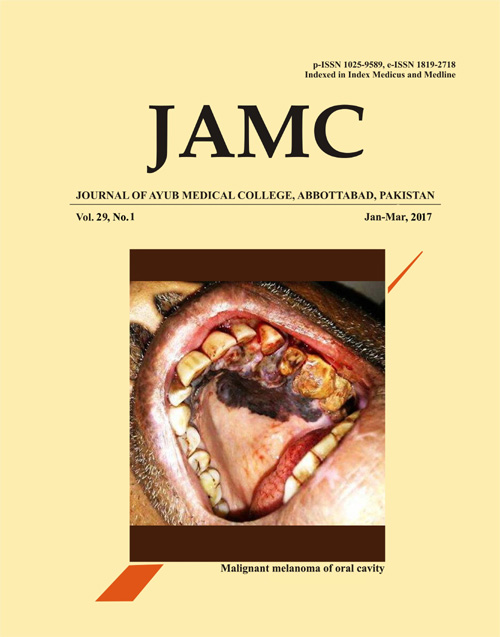TREND OF IRRATIONAL MEDICATION AMONG THE STUDENTS OF DEPARTMENT OF PHARMACY ABBOTTABAD UNIVERSITY OF SCIENCE AND TECHNOLOGY IN COMMON COLD AND FLU
Abstract
Background: Common cold and flu are mostly of viral pathogenesis with symptoms in upper respiratory tract. It is highly contagious and close inter-individual contact in winter season increase the spread spectrum. Mis-interpretation with bacterial cause leads to irrationality in its medication. Methods: A cross-sectional study was conducted among pharmacy department students in February-March 2016. Data were collected through self-administered questionnaire and expressed as percentage frequency. Results: Total 180 students were provided with questionnaire to fill the desired data. 66 out of them were reported as patients of common cold and flu. Trend of medication after compilation and analyzing data reveal that: 60.60%(n=40/66) students got irrational medication, 4.54% (n=3/66) students presents with other disease, so were declared of complex nature and 9.1% (n=6/66) patients, presented only with symptoms were counseled accordingly to the standard therapy by Health Protection Agency-UK (Management of infection guidance for primary care for consultation and local adaptation, 2013), and Columbia University Medical Center (Guidelines for the empiric use of antibiotics in adult patients – Feb, 2005) and all of them were followed for their entire therapy time. All of the counseled patients recovered successfully. Total 25.76% (n=17/66) other than that of counseled group students also got rational medication. Conclusion: Use of medicine by students in study was found irrational. National and international awareness programs about such viral disease should be designed and arranged to promote information in the community and limit the irrational medication. It also need an active health regulatory authority in undeveloped and less developed countries specially to limit the availability of prescription drugs without physician advise through availability of qualified person in pharmacies.Keywords: Rational medication; Common cold; Flu, Self-medicationReferences
Shankar PR. Medicines use in primary care in developing and transitional countries: fact book summarizing results from studies reported between 1990 and 2006. Bull World Health Organ 2009;87(10):804.
WHO. Promoting rational use of medicines: core components. 2002.
The rational use of drugs. World Health Assembly Resolution WHA39.27. Geneva, World Health Organization, 1985.
Zhang WY, Li YR, Li YJ, Li XO, Zhao WG, Lu RZ. A cross-sectional analysis of prescription and stakeholder surveys following essential medicine reform in Guangdong Province, China. BMC Health Serv Res 2015;15(1):98.
Kenealy T, Arroll B. Antibiotics for the common cold, an infection of the upper respiratory tract | Cochrane [Internet]. [cited 2016 Nov 24]. Available from: /CD000247/ARI_antibiotics-for-the-common-cold-an-infection-of-the-upper-respiratory-tract
Lessler J, Reich NG, Brookmeyer R, Perl TM, Nelson KE, Cummings DA. Incubation periods of acute respiratory viral infections: a systematic review. Lancet Infect Dis 2009;9(5):291–300.
Brown AC. Gargle method to reduce the duration of common cold symptoms. Google Patents 2015.
Lambert L. Is it flu or allergy?: review. SA Pharm J 2014;81(4):20–4.
Allan GM, Arroll B. Prevention and treatment of the common cold: making sense of the evidence. CMAJ 2014;186(3):190–9.
Coetzer R. Colds and flu medication in the elderly: review. SA Pharm J 2012;79(5):35–7.
Leder K, Sinclair MI, Mitakakis TZ, Hellard ME, Forbes A. A community-based study of respiratory episodes in Melbourne, Australia. Aust N Z J Public Health 2003;27(4):399–404.
Sexton D, McClain M. The common cold in adults: diagnosis and clinical features. UpTo-Date Homepage Internet. 2011.
Gwimile JJ, Shekalaghe SA, Kapanda GN, Kisanga ER. Antibiotic prescribing practice in management of cough and/or diarrhoea in Moshi Municipality, Northern Tanzania: cross-sectional descriptive study. Pan Afr Med J 2012;12:103.
Hashemi S, Nasrollah A, Rajabi M. Irrational antibiotic prescribing: a local issue or global concern? EXCLI J 2013;12:384–95.
Buke C, Hosgor-Limoncu M, Ermertcan S, Ciceklioglu M, Tuncel M, Köse T, et al. Irrational use of antibiotics among university students. J Infect 2005;51(2):135–9.
Published
Issue
Section
License
Journal of Ayub Medical College, Abbottabad is an OPEN ACCESS JOURNAL which means that all content is FREELY available without charge to all users whether registered with the journal or not. The work published by J Ayub Med Coll Abbottabad is licensed and distributed under the creative commons License CC BY ND Attribution-NoDerivs. Material printed in this journal is OPEN to access, and are FREE for use in academic and research work with proper citation. J Ayub Med Coll Abbottabad accepts only original material for publication with the understanding that except for abstracts, no part of the data has been published or will be submitted for publication elsewhere before appearing in J Ayub Med Coll Abbottabad. The Editorial Board of J Ayub Med Coll Abbottabad makes every effort to ensure the accuracy and authenticity of material printed in J Ayub Med Coll Abbottabad. However, conclusions and statements expressed are views of the authors and do not reflect the opinion/policy of J Ayub Med Coll Abbottabad or the Editorial Board.
USERS are allowed to read, download, copy, distribute, print, search, or link to the full texts of the articles, or use them for any other lawful purpose, without asking prior permission from the publisher or the author. This is in accordance with the BOAI definition of open access.
AUTHORS retain the rights of free downloading/unlimited e-print of full text and sharing/disseminating the article without any restriction, by any means including twitter, scholarly collaboration networks such as ResearchGate, Academia.eu, and social media sites such as Twitter, LinkedIn, Google Scholar and any other professional or academic networking site.









